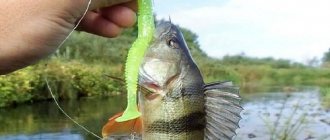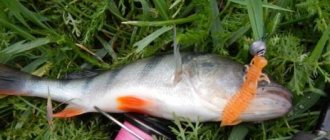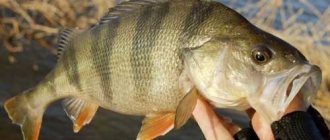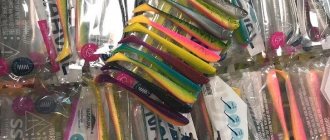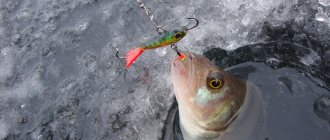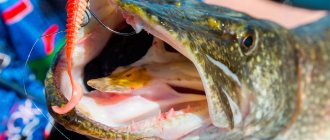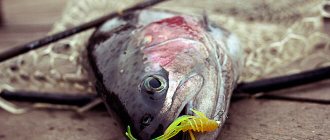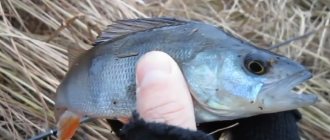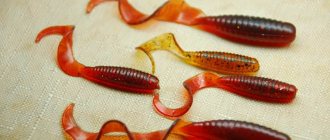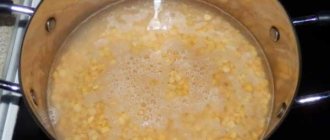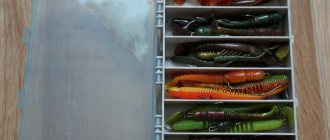Conditions for catching perch with silicone
Perch is an omnivorous predator for which it is important that the prey moves. Under natural conditions, perch feeds on the fry of other fish, crustaceans, insect larvae and even frogs. Therefore, in fishing, various options for high-frequency baits are chosen for it. The main criterion is active play in the water. Only largemouth bass (bass) bite on passive bait.
The most effective way to catch perch is considered to be uneven fishing, when the bait moves chaotically. You can use silicone on perch at the bottom and in the water column. However, if on the surface the effect is comparable to wobblers, then at great depths it has no equal.
At depths of more than 3-4 m, the classic “step” with jumps from the bottom works better. At shallow depths, wave-like movements of the nozzle without pronounced stops are more effective. In winter, perch bites better on silicone, also with small wave-like wiring. In summer, especially in overgrown standing reservoirs, a spinning rod is used, fishing is carried out at the bottom with chaotic jumping of the bait.
When fishing for perch, the bait is equipped with an offset hook. This is an important rule, since the predator lives in heavily overgrown areas.
Thanks to its streamlined shape in combination with an offset hook, this bait has high cross-country ability and is the best type of “non-hooking”.
Perch fishing spots
Perch is ubiquitous, so it can be located anywhere in the reservoir.
However, there are places where its concentration is greater and somewhere less. It is effective to catch perch from the shore near bridge piles, in shallow coastal areas, in creeks and near the border of aquatic vegetation.
On small rivers, he hunts near pools, in holes under steep banks, in coastal grass, where all kinds of small things warm themselves. Catching perch in the grass is somewhat difficult, and not everyone’s favorite, but, from the point of view of the presence of fish in such places, it is very promising.
Varieties of silicone baits for perch
The best silicone baits for perch are those that actively move in the water. They have a movable main soft part, or tail. Depending on this, active or passive baits are distinguished. Twisters and vibrating tails are popular among active ones.
Vibrotail
Vibrotail is a bait that imitates a natural fry or fish. It is distinguished by the presence of a movable flat tail. Even with minimal wiring, due to active play in the water column, the vibrotail quickly attracts the attention of perches. Vibrating tails differ in color, size and tail configuration. The most popular method is to catch perch using silicone baits with a hoof-shaped tail. Perches caught while fishing using such baits are large and weighty.
Twister
Twisters resemble vibrotails in appearance, but differ in the shape of the tail. This type of bait has a crescent shape and creates a strong vibration in the water. It is an active species and attracts the attention of even passive perch. A good effect is maintained with smooth wiring at shallow depths.
The twister, or simply “larva,” has a ribbed or smooth body and a thin tail, one or several. It is used both on classic equipment and in the form of trailers, or even put on winter lures. The most common equipment options are jig heads, offset hooks and doubles.
Worms
Slugs, or silicone worms, are used for catching perch during the season of low fish activity. This bait externally imitates the body of an earthworm and is a passive species. In water they do not have their own game, so they require special jerking. Equipped with an offset hook or a special single hook.
To catch passive perch, experienced fishermen use two types of fishing techniques:
- winding-pause-winding;
- winding-jerk-pause-jerk-winding.
crustaceans
Crayfish are effective at the bottom or in thickets and snags. In deep water they are convenient to use in bad weather conditions. As the name suggests, this bait imitates crustaceans. They use classic jig or lead rigs. On the bottom with jig wiring they resemble the movements of a defending crayfish.
Technique for catching predators with silicone
If we talk specifically about winter fishing with silicone baits, then it is not as popular as in the summer. But the most traditional types of bait have been used for several decades to catch this striped predator.
Lures made from this material are more common for use on summer gear; recently, they have successfully begun to gain momentum in winter.
One of their techniques is called Icejig. It has earned particular popularity with perch; it bites very well and, with the right approach, can be suitable for any predatory fish. In almost all cases, search tactics are preferred to standard ones, the same as when using other types of gear.
Ice jig has several subspecies. For example, vertical. It is used under ice, in which case baits that are soft to the touch are perfect. Any kind will do - slugs, twisters, etc.
Now look at your taste. A perch can bite right away, or even after sitting there for half a day you won’t catch even one. Based on this, there is no one correct way. You should always try new methods without being afraid to experiment.
Over time, more and more new soft baits began to appear. Recent discoveries - foam and rubber materials, small fry. But some still continue to be very skeptical about them and do not use them in winter.
Let's figure out how low temperature will affect silicone. Don't forget to consider the quality of silicone used. Not everyone can handle the cold temperatures when ice fishing. You are unlikely to be able to find special baits for winter fishing right away. Therefore, it is important to develop the skills to make the right choice.
Poor quality and too soft silicone will most likely harden in the cold and become completely immobile. This one will not be able to attract any fish. But with the right selection of silicone, it will retain its original appearance and behave well under water.
To prevent the products from becoming covered with a layer of ice, they must be stored in a bag or a special thermal bag. After you take it out, you need to put it in the water immediately. This is most likely why some fishermen prefer to avoid this material.
But if you use these recommendations, then the likelihood of a big catch is very high. If traditional baits do not work at some point, then silicone can help out the situation.
The most important aspect of jigging fishing is choosing the right equipment. There is a huge assortment of rubber dummies in any store, so you can find something that suits you. You can go a more complicated way and build a bait with your own hands, there are a lot of options.
If you don’t want to invent anything, use the most ordinary jing equipment, it will never let you down. Choose one that is suitable for vertical fishing.
Absolutely any fishing rod can be used. The equipment must be selected according to thickness, based on the weight of the sinker. Tackle for trolling is suitable for large wolves. For lighter gear, use a nod rod.
Equipment for fishing with silicone
Catching perch with silicone largely depends on the game and mobility of a vibrating tail or slug. Therefore, it is important to properly equip the bait so as not to deteriorate its properties.
Today, about ten different rigging methods are used, which are intended for different conditions and wiring techniques. The following types are recognized as the most effective and popular for catching perch:
- Jig head. A classic type of equipment used by beginners and experienced fishermen. A head weight and a fixed hook are used. Jig heads are available weighing from 1 to 10 g and with hooks of different sizes. The weights themselves also differ in shape: hoof, ball, ellipse, etc.
- Articulated. The design consists of a weight head and an offset hook. Doubles and tees are used. It differs in that the weight has two eyes: one for the offset hook, and the second is where the leash with the main fishing line is threaded. In this design, the silicone bait always remains mobile and creates active vibrations when retrieving. Suitable for vibrating tails, twisters and passive worms. If necessary, it is easy to make a “non-hooking” one.
- Retractable leash. This type of equipment involves the use of a weight on the main line and an additional leash with bait. This type is indispensable if you need to cast light bait far. Additionally, the weight holds the silicone in the bite zone, which is convenient in strong currents.
- A drop shot resembles a retractable leash, only in this rig the hook with bait is attached directly to the main line. The weight is at the very bottom.
- Tirrett is a rig that is used on a snag bottom. It involves the use of a plow-shaped weight that passes freely along any bottom.
- Texas - modernized equipment for fishing in snags. The bait is attached to an offset hook, and a bullet-shaped weight with a through hole is put on the fishing line. Just behind the weight is a bead that protects the hook knot. As a result, the bullet weight walks freely along the fishing line.
- Carolina is a subspecies of the Texas rig, where the hook with bait is located on a separate leash.
- Split shot is a rig for shallow depths. The bait is attached to the main line, and a simple float shot is fixed on top (at a distance of 30-40 cm).
What determines the catchability of silicone?
The catchability of silicone depends on several factors: color, size, appearance, smell. Lures are available in different colors and scents. For example, silicone crustaceans and fish with the smell of anise, crab, garlic. Practice shows that under the same conditions, but in different places, the result is different.
Color
There is an opinion that the color of the bait should be chosen based on the time of year. In summer, silicone of dark natural colors turns out to be effective: brown, dark green, marsh. In the spring, perch are attracted to bright baits, and in the fall - translucent ones.
Many fishermen advise catching large perch using red and yellow baits. But they are only suitable for dark, muddy water with poor illumination of the reservoir. In clear waters, silicone in natural colors is used.
Smell
Scented baits are often used because... the smell enhances the catchability of silicone. In this case, it is not necessary to buy already impregnated nozzles. Silicone absorbs aroma well, so it’s easy to create the desired scent at home.
The most attractive aroma for perch is considered to be the smell of meat, garlic, fish and shrimp. At home, you can use herring and shrimp oil, liver extract, dry garlic and ready-made sprays.
Edible and inedible silicone
The best silicone bait for perch has long been associated with edible material from Lucky John. This is the most popular type of bait in the domestic market. They are much more convenient for beginners in wiring and imply greater freedom in choosing the type. Such slugs are conventionally called edible, but unlike rubber, they are safe for fish and the reservoir.
Sports fishermen were the first to use edible twisters. Literally, the fish doesn’t eat the bait, but they like to try it. Perch does not always swallow its prey whole. Often he tries it a little at a time. Inedible silicone must be hooked immediately, as there is a high probability of missing the right moment and the perch will spit out the bait. You can take a pause with edibles. This is the advantage of edible rubber for perch fishing.
Secrets of perch hunting
- The best time to catch “striped” fish with a twister is dawn. It is at this time that there is a good opportunity to catch a trophy predator. In the evening, active biting is also possible.
- Catching perch at night is almost impossible.
- Perch prefers a schooling lifestyle. Therefore, you should not stop wiring if one predator chased the bait, tried edible silicone and did not attack it. Often, a hungrier bass can react almost immediately.
- How to prepare dough for crucian carp
- The best silicone crustaceans: TOP 5
- Bait Breath Mosya – passive food for perch
- Wobblers for pike in spring. Rating of the best
How to increase the effectiveness of silicone baits?
The effectiveness of the catch depends on the quality of the silicone. The rating of silicone baits for perch includes twisters, vibrotails, slugs from such brands as Lucky John (Belarus), Fanatik (Ukraine), Relax, Keitech.
Top silicone vibrotails:
- Boxer 3.5 from Fanatik - soft baits with a thickened belt in the middle of the body for hook release. Active tail play in still water, different colors. Made from edible silicone.
- Ponton 21 Awaruna is a jig bait with a high-frequency action, which is transmitted to the entire surface due to transverse ribs in the lower part of the body.
- Bugsy shad Lucky John is a vibrating tail with legs on the sides of the body. This type of bait is effective when fishing even for passive perch.
- Swing impact Keitech - has an elongated ribbed body, the tail actively plays even with a slow retrieve.
- The Tioga Lucky John is a popular bait that is effective in remote areas due to its long tail.
Even the most reliable baits do not always produce results. Experienced fishermen advise trying to improve the effectiveness of silicone on your own. For example, you can enhance the aroma or add brightness and color.
- Stripes and specks. On light and translucent baits it is easy to imitate the color of a fish. In the area of the tail and back, chaotic lines and specks are applied with a dark marker.
- Shine. Perch actively reacts to sparkling baits. If you can’t find a suitable pattern on sale, glitter varnish will help. They can cover the entire rubber or highlight individual parts of the body with a bright color.
Another important piece of advice from experienced fishermen: do not throw away spoiled bait. You can make one from two parts of torn baits. As practice shows, perch responds well to non-standard shapes and colors. To connect two parts of silicone, their edges need to be heated over a candle and pressed tightly. Combinations of bait and a wobbler give good results: you can fish this way in any conditions and on any body of water.
